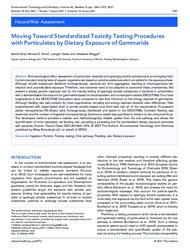Moving Toward Standardized Toxicity Testing Procedures with Particulates by Dietary Exposure of Gammarids
Götz, Astrid; Imhof, Hannes K.; Geist, Juergen; Beggel, Sebastian, 2021: Moving Toward Standardized Toxicity Testing Procedures with Particulates by Dietary Exposure of Gammarids. In: Environmental Toxicology and Chemistry, Band 40, 5: 1463 - 1476, DOI: 10.23689/fidgeo-4370.
 |
View/
|
Ecotoxicological effect assessment of particulate materials and sparingly soluble substances is an emerging field. Current standard toxicity tests of aquatic organisms are based on soluble substances which are added to the aqueous phase. Although soluble substances distribute homogeneously, particles can form aggregates, resulting in inhomogeneous distribution and unpredictable exposure. Therefore, test scenarios need to be adapted to overcome these uncertainties. We present a dietary particle exposure tool for the toxicity testing of sparingly soluble substances or particles in combination with a standardizable food source for gammarids based on decomposition and consumption tablets (DECOTABs). Four food supplements in the DEOCOTAB formulation were compared to test their influence on the energy reserves of gammarids. Although feeding rate was constant for most supplements, mortality and energy reserves revealed clear differences. Tabs supplemented with algae‐based phyll or animal protein–based trout food best met all of the requirements. Fluorescent plastic microparticles (10–65 µm) were homogenously distributed and stable in the DECOTABs. Constant feeding was observed, and the number of ingested microparticles by Gammarus roeseli was quantified in relation to the consumed food. The developed method provides a realistic and methodologically reliable uptake from the oral pathway and allows the quantification of inner exposition via feeding rate, providing a promising tool for standardized dietary exposure scenarios with particles. Environ Toxicol Chem 2021;40:1463–1476. © 2021 The Authors. Environmental Toxicology and Chemistry published by Wiley Periodicals LLC on behalf of SETAC.
Statistik:
View StatisticsCollection
This is an open access article under the terms of the Creative Commons Attribution‐NonCommercial License, which permits use, distribution and reproduction in any medium, provided the original work is properly cited and is not used for commercial purposes.

